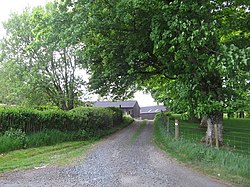Difference between revisions of "Caerlanrig"
m |
|||
| Line 19: | Line 19: | ||
==Name== | ==Name== | ||
| − | The first element of the name 'Caerlanrig' is probably from the extinct Cumbric language, ''cair'' meaning 'fortification' (which appears in | + | The first element of the name 'Caerlanrig' is probably from the extinct Cumbric language, ''cair'' meaning 'fortification' (which appears in Welsh as ''caer''). The second element is generally taken as Cumbric ''lanerx'', meaning 'clearing' (as the Welsh ''llanerch'').<ref>Coates, Richard: [http://www.sussex.ac.uk/linguistics/documents/rc_britons.pdf Invisible Britons: the view from toponomastics], in George Broderick and Paul Cavill, eds, Language contact in the place-names of Britain and Ireland. Nottingham: English Place-Name Society, 41-53, </ref> Another suggestion is that the name is Cumbric ''cair'' with the Old English ''lang'' ('long') and ''hrycg'' ('ridge').<ref>Bethany Fox:, 10 (2007), http://www.heroicage.org/issues/10/fox.html 'The P-Celtic Place-Names of North-East England and South-East Scotland', The Heroic Age]</ref> |
==Border reiver== | ==Border reiver== | ||
| − | The village is best known for being the site where John Armstrong of Gilnockie, notorious member of Armstrong | + | The village is best known for being the site where John Armstrong of Gilnockie, notorious member of Armstrong family and brother of Thomas, Laird of Mangerton was captured and hanged by King James V for being a reiver. |
==Outside links== | ==Outside links== | ||
Latest revision as of 23:17, 6 December 2016
| Caerlanrig | |
| Roxburghshire | |
|---|---|
 Carlenrig Farm | |
| Location | |
| Grid reference: | NT399048 |
| Location: | 55°20’1"N, 2°56’56"W |
| Data | |
| Post town: | Hawick |
| Postcode: | TD9 |
| Dialling code: | 01450 |
| Local Government | |
| Council: | Scottish Borders |
Caerlanrig is a hamlet in the parish of Teviothead in Roxburghshire. It sits beside the River Teviot, six miles north-east of that river's source, and ten miles south-west of Hawick.
Contents
Name
The first element of the name 'Caerlanrig' is probably from the extinct Cumbric language, cair meaning 'fortification' (which appears in Welsh as caer). The second element is generally taken as Cumbric lanerx, meaning 'clearing' (as the Welsh llanerch).[1] Another suggestion is that the name is Cumbric cair with the Old English lang ('long') and hrycg ('ridge').[2]
Border reiver
The village is best known for being the site where John Armstrong of Gilnockie, notorious member of Armstrong family and brother of Thomas, Laird of Mangerton was captured and hanged by King James V for being a reiver.
Outside links
| ("Wikimedia Commons" has material about Caerlanrig) |
- Gazetteer for Scotland: Caerlanrig
- Photographs of 'A tour of the Armstrong Borderland', including Gilnockie's gravemarker
References
- ↑ Coates, Richard: Invisible Britons: the view from toponomastics, in George Broderick and Paul Cavill, eds, Language contact in the place-names of Britain and Ireland. Nottingham: English Place-Name Society, 41-53,
- ↑ Bethany Fox:, 10 (2007), http://www.heroicage.org/issues/10/fox.html 'The P-Celtic Place-Names of North-East England and South-East Scotland', The Heroic Age]